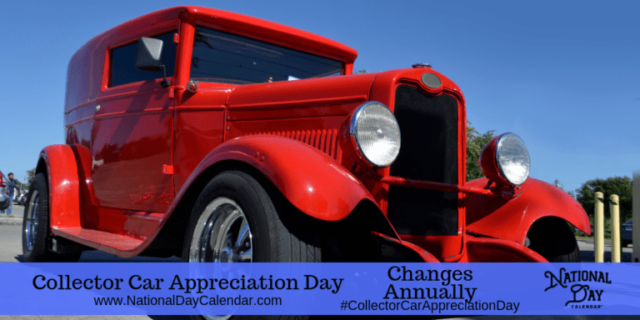
Each year in July, Collector Car Appreciation Day recognizes the vital role automotive restoration and collection plays in American society.
- The history of the automobile is very rich and dates back to the 15th century when Leonardo da Vinci was creating designs and models for transport vehicles.
- Americans have had a fascination with the automobile since the first U.S. horseless carriage was demonstrated in 1893 by the Duryea Motor Wagon Company. The romance of the motor took us from rough country roads to iconic highways and byways. With the Ford assembly line came affordability.
- We associate each era with a certain car. Whether we ride in a Prohibition-era Cadillac Sedan, 1950s era muscle car or our grandfather’s pickup truck, they take us back.
- The first full-scale, self-propelled mechanical vehicle was released in 1769. It was a steam-powered tricycle that was used to haul cannons around town. (But, it weighed 8,000 pounds!)
- The Benz Patent-Motorwagen is believed to be the first modern automobile. German inventor Carl Benz applied for the patent in 1886, and later, his wife took it on the first-ever, long-distance drive.
- In 1913, the Ford Model T became the first mass-produced automobile. Three years later, 55 percent of all cars in the world were Model Ts, which is a record yet to be broken.
- The 1964 Pontiac GTO is widely regarded as the first “muscle car.” Pontiac owned the muscle scene in the early 1960s, but by 1968, that car had plenty of competition.
- Pontiac released the first true muscle car, the Pontiac GTO in 1964. It was basically a two-door Tempest with a 389 V8 engine. It had a fancy trim level and GTO insignia on the front grille and side fenders.
- The GTO name was borrowed from the Ferrari 250 GTO and means “Gran Turismo Omologato.” The name sounded good, so Pontiac decided to use it, giving its new model some Italian charm and exotic flair.
- The Ford Mustang also made its debut in 1964. It was officially unveiled at the World’s Fair in Flushing Meadows, New York. That same day, the car also debuted in showrooms across America, and close to 22,000 Mustangs were purchased.
- The first Chevrolet Camaro to ever come off the production line was black. And originally, the Camaro was going to be called the Panther.
- The 1969 Dodge Charger Daytona was banned by NASCAR. The car was named for the Daytona 500, and with its record-breaking speed, it won the first race it was entered in. Unfortunately, however, it was just too fast to last.
- Pontiac’s “The Judge” (a 1969 GTO) was named after a TV show skit. At the time, John DeLorean was the man in charge, and he chose to name the car after a show he watched and liked: “Rowan & Martin’s Laugh-In.”
- “The Judge” was also featured in what’s considered the first-ever rock music video. In the original TV commercial for this car, Paul Revere and the Raiders sang a song they wrote about it.
- The original “Dukes of Hazzard” show featured a total of 309 Dodge Chargers – all 1969 editions. How can you tell a 1969 Charger from a 1968? Look for the split grille on the front of the ’69 model.
- A 1977 Pontiac Trans Am starred in the movie “Smokey and the Bandit.” Four were provided for the movie – all of which were badly damaged during production.
- Each member of The Monkees was given a new Pontiac GTO. As part of their contract, everyone on the hit TV show got a hot car for personal use.
- Flip-out headlights on the Dodge Charger were used for the last time in 1973. Apparently, they didn’t seem very family friendly.
- There is no 1983 Chevrolet Corvette. Instead, Chevy skipped a year and introduced an all-new model in 1984. However, there were prototypes of the car, and all but one was destroyed. It now lives in the National Corvette Museum in Bowling Green, Kentucky.
- Only 11 prototypes of the Porsche 916 exist. It’s one of the rarest cars in the world, as it was soon replaced by the less expensive Porsche 911.
- Chrysler’s 426 HEMI engine was called “the elephant.” It was extremely large and extremely powerful. In fact, at Daytona in 1964, the vehicles that placed first, second and third all had this engine – which is why NASCAR would eventually change its engine-related rules.
- The most expensive car ever sold at a public auction was a 1954 Mercedes-Benz W196R Formula 1 race-car. In 2013, it went for a staggering $30 million.
- In October 2013 a 1963 Ferrari 250 GTO racer became the world’s most expensive car, selling to a private buyer for $52 million. The red competition car, formerly owned by the Greenwich, Connecticut-based collector Paul Pappalardo, was acquired by an unidentified buyer in a private transaction, according to the Bloomberg news agency.
- The word “car” is believed to originate from the Latin word carrus or carrum (“wheeled vehicle”), or the Middle English word carre (meaning “two-wheel cart”, from Old North French). In turn, these originated from the Gaulish word karros (a Gallic chariot). It originally referred to any wheeled horse-drawn vehicle, such as a cart, carriage, or wagon.
- The word “automobile” is a classical compound derived from the Ancient Greek word autós, meaning “self”, and the Latin word mobilis, meaning “movable”. It entered the English language from French, and was first adopted by the Automobile Club of Great Britain in 1897.
- The United States has more cars than any other country in the world, at 300 million.
- There are more cars than people in Los Angeles.
- The Toyota Corolla is by far the best-selling model of car ever made, with close to 50 million units sold since its launch in 1966.
- Approximately 65 percent of all Rolls-Royce cars ever built are still on the road today.
- A single car has about 30,000 parts, counting every part down to the smallest screws.
- The “new car smell” is composed of over 50 volatile organic compounds.
- On average, cars are parked 95% of the time.
- The world’s first automobile accident occurred in Ohio City, Ohio in 1891. Irish scientist Mary Ward was riding in a steam-powered automobile built by her cousins. As they rounded a bend in the road, Ward was thrown from her seat and fell in the vehicle’s path. One of the wheels rolled over her and broke her neck, killing her instantly.
- The only cars that Cuban citizens can own legally are cars created and bought before 1959. After this year, the Cuban government seized all of the cars, and owns them all to this day. Most of the pre-1959 cars in the country are from the United States.
- The report from U.S. News and World Report show only 18 percent of U.S. drivers know how to operate a stick shift.
- Residents of Churchill, Canada leave their cars unlocked to offer an escape for pedestrians who might encounter Polar Bears on Main Street.
- South African residents can legally attach small flamethrowers to the side of their cars to provide defense against carjackers.
Sources”












